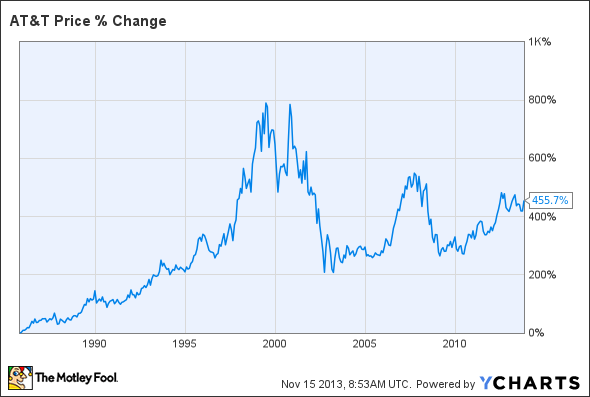Over the past few weeks I've been working my way through the nine dividend aristocrats on the Dow Jones Industrial Average (^DJI 0.40%), and this week it's AT&T's (T 1.02%) turn in the spotlight. The company's consecutive dividend streak started in 1985, and its current payout is $1.80, giving the stock a yield of 5.1%. That makes AT&T by far the highest yielding stock on the Dow. Verizon (VZ 1.17%) comes in next at 4.2%.
The past
Over the past 28 years, the dividend has risen more than 980%.
T Dividend data by YCharts.
That's a pretty impressive chart, if you ask me.
I have written in the past that while a stock's current yield is important to know for investors looking to buy new shares of a company, if you're already holding a stock, it's better to look at the price you paid for the stock and compare that amount with the current dividend, thus giving you a better idea of what your individual yield is. For example, somebody who bought AT&T back on Nov. 15, 1985, at an unadjusted share price of $6.65 would have a yield of 27% based on the current dividend of $1.80, not the posted 5.1% that investors buying today would garner.
So how has the stock price performed since AT&T started increasing its dividend in 1985?
On an unadjusted basis, someone who's held AT&T since 1985 would have experienced a 456% return, or 6.3% annualized (the calculation being based on the Oct. 31, 2013, closing price). That performance, though impressive, wouldn't beat the S&P 500's unadjusted return of 825%, or 8.3% annualized, over the same period. But reinvesting all of AT&T's dividends since 1985 raises the return to 1,835%, or 11.2% annualized. That beats even the S&P 500's dividend-adjusted return of 1,500%, or 10.44% annualized.
The future
So AT&T's dividend has made the difference for investors during its 28-year run, but what can investors expect moving forward?
They say past performance doesn't indicate future results, but the dividend aristocrats have certainly proved over the years that their dividend payments are stable and that investors can expect yearly increases. What's more, the Dow's aristocrats primarily operate in consumer-facing industries, which can help insulate them from economic downturns, whereas business-to-business companies may face problems in difficult environments.
Of course, even the best company can fail. Not that AT&T is in imminent danger of going under, but the company is facing some headwinds in the near term, as growth in the U.S. wireless service industry begins to slow. Competitor Verizon has struggled to find growth within its domestic market and even turned to buying the 45% stake Vodafone held in Verizon Wireless as a way to grow its profits. Rumors also say AT&T may buy a European telecom company, while Verizon has supposedly been looking into purchasing a small Canadian firm.
The fact remains for now, though, that AT&T is the dominant player in the U.S. telecom market, and its position isn't really being challenged. The revenue flow it generates from users is safe and should continue to produce enough cash so that it can continue paying and increasing its dividend for a few more years. But looking further out, AT&T will need to grow its revenue stream, which means moving into new markets outside the United States if it wants to post 28 more years of yearly dividend increases.







